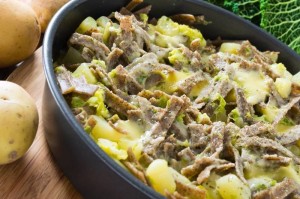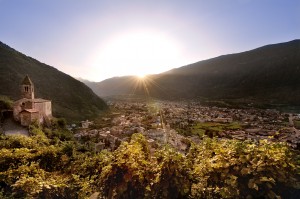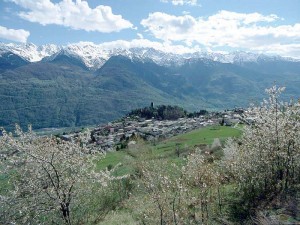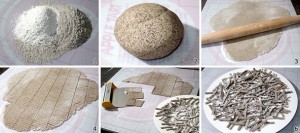Pizzoccheri
According to the Sertoli Salis the term pizzoccheri, whose name would be the equivalent of Pinzocheri, indicate “bigoted people”, unimportant. More than modesty is certainly a certain inclination to the use of playful names such as it is the term sciatt, that for the original form of these ungainly buckwheat pancakes, denotes, in the local dialect, toads . But since the tellini eat these tasty pizzoccheri?
According to Giuseppe Barretta, a researcher of the Braidense National Library the “PINZOCHERI, today called pizzoccheri, made with buckwheat was already tasted at the time of Meluzza, who was the inventor, a woman who knew a lot of cooking. The comaschi were not only the people of Como and the surrounding area, but saying the comaschi meant the entire population of the lake from the Valtellina, where the Diocese of Como was extended.
Buckwheat was therefore used in the kitchen since the fourteenth century, along with other cereals: millet, barley, foxtail millet, oats. The Meluzza gave this cereal taste by adding more cheese, butter, vegetables.
In addition to pizzoccheri here it is the polenta taragna also made with buckwheat, certainly before the pizzoccheri. Homeland of pizzoccheri is the Alta Valtellina, with capital Teglio.”
The history testifies to that in 1192 the Emperor Henry VI imposed in Teglio the obedience to the ghibelline Como. The followed centuries, until you get to the Treaty of Alliance with the Grisons in 1512, were a series of domains: now the Guelphs of Milan, now the Ghibellines of Como. Remember that even today the Valtellina is under the archbishopric of Como. Another historical news to be reckoned with is of course the visit of Hortensius Lando at Besta family in Teglio in 1500. It is assumed then that on that occasion he tasted the famous pizzoccheri of Teglio. In detailed study carried out by Professor Nella Credaro Porta (Popular World in Sondrio, Lombardia, and its Territory) we find numerous other documents that refer to this dish.

In 1798 the work of Lehmann “Die Republik Graubunden”, which then covers the area of Grisons, which was part of the Valtellina, with a specific reference to Teglio area we find:
(…) The prosperous farmer live well. Consumes infact the products of his land. Milk, cheese and butter are served daily in abundance. Polenta, Malonz, cheese soup, the Perzockel, the soup and the Tasch are his favorite dishes for meatless day. (…) The “Perzockel” are a kind of noodles made of flour and two eggs. The pasta comes cooked in water, then add the butter and spreads quickly grated cheese. (…)
Even in the second half of the 800, there are texts that speak of pizzoccheri:
(…) It will make great use of flour and some coarse pastas which are sprinkled with butter and cheese like noodles, called pizzoccheri, which the Sondriesi are very gluttons (…)
More precise information regarding the Pizzoccheri of Teglio we find in 1889 with Bartolomeo Besta, a local doctor, through his manuscript “the Jacini investigation” (Agrarian Investigation about the conditions of the agricultural class in 1882). Through his testimony, therefore, we can find a feed model of agricultural producers of this valleys. Procurement system that is based on self-sufficiency of its products. According to the Besta the 3 dishes that had as basic ingredient the buckwheat were:
(…) “Tagliatelli, called pizzoccheri, boiled in water and then seasoned with a good dose of dry cheese and butter, the polenta taragnia and the sciatt or chiscioi” (…) These were also considered special dishes.
Always according to Professor Nella Credaro Porta “The PIZZOCCHERI were and are the most important dish of the area stretching from Grosio to Castione, with its epicenter in Teglio, and it was not even a plate of the poorest farmers, because it presupposed to be processed on a table, which does not always exist in modest houses. It is coarse white flour and buckwheat noodles into parts that vary by villages. Cooked in salted water in which are placed potatoes or cabbage and/or swiss chard into pieces, the pizzoccheri are drained with the slotted spoon and dressed in layers with fat cheese slices, cheese grits and coverd with abudant butter fried well dark with garlic (…) ”
The poorest farmers, to obviate the problem of not owning the table for rolling dough, preparing the pasta as if to the pizzoccheri, they took in their hands small pieces and gave the form of gnocchi with a spoon and then cooked and seasoned them as the pizzoccheri.
Ingredients (serves 4)
400 g of buckwheat flour
100 g of white flour
200 g of butter
250 g of cheese Valtellina Casera DOP
150 g of grated Parmesan cheese
200 g of cabbage
250 g of potatoes
a clove of garlic, pepper

Preparation:
Mix the flours, mix with water and work for about 5 minutes.
With a rolling pin roll the dough to a thickness of 2.3 millimeters, cut in strips of 7-8 centimeters. Overlap the strips and cut widthwise, getting noodles width of about 5 mm.
Cook the vegetables in salted water, the cabbage into small pieces and the potatoes into chunks, add the pizzoccheri after 5 minutes (the potatoes are always present, while the cabbage can be replaced, according to the seasons, with swiss chards or green beans). After ten minutes collect pizzoccheri with a slotted spoon and pour a part in a very hot pan, sprinkle with grated Parmesan cheese and Valtellina Casera DOP slices, proceed alternating pizzoccheri and cheese. Fry the butter with the garlic leaving browning well, before pouring on pizzoccheri. Serve the pizzoccheri very hot, without stirring, with a sprinkling of black pepper.








Leave a comment